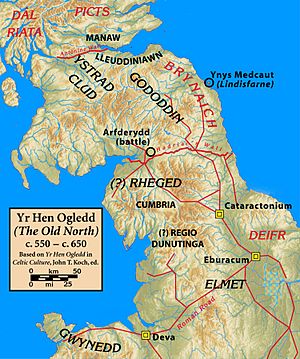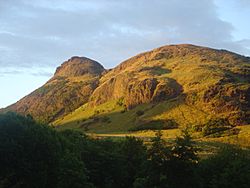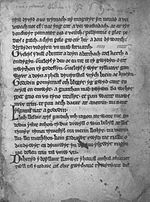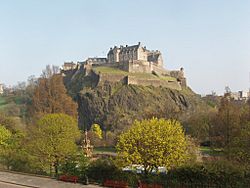Eidyn facts for kids

Eidyn was an important region in ancient Britain, located around what is now Edinburgh. This was during a time called the sub-Roman and early medieval periods, roughly from the 5th to the 7th centuries. The heart of Eidyn was a strong fortress called Din Eidyn. Many historians believe this fort was on Castle Rock, which is where Edinburgh Castle stands today.
Eidyn was the most important part of the Brittonic kingdom of Gododdin. It was a powerful place in the Hen Ogledd, also known as the Old North. This was an area in what is now southern Scotland and northern England where people spoke Brittonic languages.
People have lived on Castle Rock almost continuously since the Bronze Age. It was a stronghold for the Votadini tribe during the Roman times. Later, it became the main center for their successors, the Gododdin kingdom. Eidyn's importance is shown in a famous medieval poem called Y Gododdin. This poem tells the story of a group of warriors who gathered in Eidyn around 600 AD for a battle. Eidyn was eventually conquered by the Angles in 638 AD.
Eidyn left a lasting mark on history. It is the origin of the name "Edinburgh" in both English and Scottish Gaelic. It also remained famous in Brittonic stories for many centuries. The poem Y Gododdin was copied and shared for a long time. Eidyn also appears in old Welsh stories and poems, often remembered as the northern edge of the Britons' lands.
Contents
What Does Eidyn Mean and Where Was It?
The name "Eidyn" and its exact location are closely connected. We know it included the fortress of Din Eidyn. "Din Eidyn" is a Brittonic name that means "the dun" or "hillfort of Eidyn". This fort was in modern-day Edinburgh.
Other place names suggest Eidyn was a larger area. For example, the name of Carriden, about eighteen miles to the west, comes from Caer Eidyn. Caer means "fort" or "walled city". Many scholars believe Eidyn covered a large part of the area south of the Firth of Forth. It might have touched or even included the region known as Manaw Gododdin.
Eidyn is the source of the name "Edinburgh" in both English and Scottish Gaelic. When the Angles took over the area in the 7th century, they changed the Brittonic word din in Din Eidyn to their Old English word burh. This created the name "Edinburgh". In Scottish Gaelic, the name became Dùn Èideann. The exact origin of the name Eidyn itself is not known.
History of Eidyn
People started building fortified communities around Edinburgh during the Bronze Age and early Iron Age. During the early Roman period in Britain, the area was part of the Votadini tribe's land. The Votadini were mostly independent but were influenced by the Romans in the 2nd century. Around 143 AD, Emperor Antoninus Pius began building the Antonine Wall north of the Votadini's land. Its eastern end was probably at Carriden.
The Votadini might have become a Roman client kingdom. This meant they were allies of Rome and were tasked with defending the border against the Picts and Scots. For hundreds of years, Eidyn was seen as Britain's northern border against these groups.
From Votadini to Gododdin
After the Romans left Britain, the Votadini became the Gododdin kingdom. Eidyn was very important to the Gododdin and the wider Hen Ogledd region. This is clearly shown in the early medieval poem Y Gododdin. The poem tells how 300 brave warriors from across the Brittonic world gathered at Din Eidyn. They were preparing for a raid on Catraeth (which was probably Catterick in North Yorkshire) around 600 AD.
The poem's language is complex, making it hard to know the exact historical events. One idea is that a Gododdin ruler named Mynydawc Eidyn called the warriors to attack the Angles at Catraeth. The warriors feasted for a year before their journey. Sadly, almost all of them were killed in the battle.

The Fall of Eidyn
In the 7th century, the Gododdin kingdom began to weaken. At this time, Eidyn might have been a smaller kingdom within Gododdin. Its lords may have only controlled their own area, not the entire Gododdin territory. The Annals of Ulster, an old Irish record, mentions the "siege of Etin" in 638 AD. This event likely refers to the final conquest of Lothian by the Angles. This is also the earliest clear historical mention of Eidyn.
Eidyn seems to have remained under Anglian control for most of the next three centuries. However, there isn't much historical or archaeological evidence from this period. It's unclear if a fort remained at Din Eidyn during this time. The Annals of Clonmacnoise state that Æthelstan of England "spoiled the kingdom of Edinburgh" in 934 AD. This suggests that a significant fortification existed there then. The Chronicle of the Kings of Alba says that the Scots conquered Eidyn and its fort under King Indulf, who ruled from 954–962 AD. Around this time, a noble estate was built there, which led to the creation of the royal castle in the 11th century.
Din Eidyn: The Stronghold
The most important place in Eidyn was its stronghold, Din Eidyn. The first settlement at Din Eidyn during the Iron Age was likely a dun or hill fort. Remains of such forts can be found at Arthur's Seat and Castle Rock (where Edinburgh Castle is now). There are also other hilltops in the area with similar remains.
Archaeologists generally agree that the Castle Rock site was Din Eidyn. Evidence shows it was an important center continuously from Roman times into the Middle Ages. Archaeological findings suggest Castle Rock has been lived on since the Bronze Age. This might make it the oldest continuously occupied site in Scotland.
During the Iron Age, the site was probably a fortified village. It was one of several in the Edinburgh region. Its location was easy to defend, which gave it an advantage over other nearby sites like Arthur's Seat. In the Roman era, Castle Rock supported a thriving settlement. It likely included a hillfort, perhaps with a broch (a type of roundhouse). At this time, Castle Rock was one of the main centers of the Votadini. However, it was much smaller than Traprain Law, which was ten times larger.
In the early medieval period, Din Eidyn became the main political center of the Gododdin kingdom. This happened especially after Traprain Law was abandoned in the early 5th century. When the Gododdin kingdom declined in the 7th century, the lords of Din Eidyn might have only controlled the Eidyn area, not the whole Gododdin territory. After the Angles conquered Eidyn, the Din Eidyn location remained a fortified settlement for the Angles, and later for the Scots.
Eidyn's Lasting Legacy

Eidyn remained famous in Brittonic stories long after the Angles conquered it. Several old writings mention Eidyn as the northern border of the Britons. The poem Pa gur yv y porthaur? (meaning What man is the gatekeeper?), written around the 10th century or earlier, talks about King Arthur and his warriors defending "Eidyn at the border". The poem describes Arthur's group fighting strange creatures on the "Mountain of Eidyn". It also mentions Bedwyr (who later became Sir Bedivere in Arthurian legends) fighting a monster at the "shores of Tryfrwyd".
Similarly, an old Welsh story called Welsh Triad 33 mentions a warrior named Llawgat Trwm Bargod Eidyn (Heavy Battle-Hand of the Border of Eidyn). He killed Afaon, the son of Taliesin, in one of the "Three Unfortunate Slaughters of the Island of Britain".
The poem Y Gododdin, which tells about Eidyn, was copied and shared in many manuscripts during the Middle Ages. The only existing version is from the 13th-century Book of Aneirin. However, clues in the text suggest that the scribes copied it from two or three older manuscripts. Also, people connected to Eidyn, like Clyddno Eidyn and his son Cynon ap Clydno (who survived the battle of Catraeth), appeared in poems, Welsh Triads, and Arthurian stories throughout the Middle Ages. An old family tree of Clyddno's family might even show the royal line of Eidyn.


